So you’re considering taking a cruise to Antarctica, are you? Visiting the White Continent is not a normal vacation, however, so you’re probably looking for practical information about what the trip entails, what you’ll do there, and what life is like on the ship.
Here on this page we discuss all of that. I’ve written this article about what to expect on the cruise to Antarctica to prepare you for everything that you will experience on this incredible journey, including that notorious Antarctic weather.
This page is all about life on the cruise, including the time you’ll spend on the boat and on land. I have a separate article about how to prepare and book the cruise to Antarctica that is also important to read before deciding to visit Antarctica. That article discusses trip costs, room types, last minute details, where the ships leave from, and so on.
On this page I also don’t go into specifics about the places you will visit in Antarctica either. For that information, be sure to check out the links below. If you’re only planning on going to Antarctica, you can skip the articles about the Falkland Islands and South Georgia Island, though I highly recommend doing the extended cruise to the Falklands and South Georgia!
- Discover the Falkland Islands
- Fall in Love with King Penguins on South Georgia Island
- Discover the White Continent on a Cruise to Antarctica
Antarctic Weather
Let’s start with the weather. You know Antarctica is cold. I discuss what to pack for this journey in my post about preparing for the cruise. Your cruise operator will have a heavy jacket for you, but you need to bring plenty of other warm clothes. Don’t fret though, it’s not always as cold as you might think!
Temperature
Temperatures can vary greatly in the Antarctic summer (Dec-Feb). It might be 55 degrees (13 C) one day and 20 degrees (-7 C) the next. Typically it’s quite cold though, with average highs just above freezing. We had one incredibly nice day where it was warm enough to walk around Antarctica in a T-shirt, but not everyone gets that experience.
Also remember that you’ll be down around 63 degrees south in latitude, so the nights are really short, given how close you are to the Antarctic Circle. If you’re there in December or January you might only have 2-3 hours of darkness each night.

This means that the temperature doesn’t vary much throughout the day, usually only 1-2 degrees celsius. All this to say that the nights are not any colder than the days.
The Falklands and South Georgia Island are considerably warmer, often 40-50 degrees (4-10 C). I found I rarely need the parka there if the sun was out. I usually walked those islands in a light rain jacket or a long-sleeve T-shirt.
The Falklands and South Georgia are considerably further north, however, so you will get a few hours of complete darkness every night if you opt for the longer cruise.
Rain and snow
Antarctica is actually the largest desert in the world. Believe it or not, it doesn’t rain or snow much. When it does snow, the snow remains for a while though. While you might not get clear sunny skies every day, you can reasonably expect not to be trampling around Antarctica in the rain or a blizzard.
The same cannot be said about South Georgia and the Falklands though. These small mountainous islands can be pretty dreary. It’s fitting that they are British territories, as the rain and clouds will remind you of London.
That being said, we had some wonderful weather on both islands. Brilliant sunshine and warm weather. This is not that common though, so don’t expect blue skies in your pictures.
Wind
The real difficulty you will face will be the wind. The wind can be flat out brutal in Antarctic waters as well as the islands. Temperatures will often feel considerably colder than they actually are due to the wind chill.
The main detriment of the wind, however, is its effect on the water. Windy days can be very choppy on the water, even for a large ship. The wind can also ruin your trip by preventing you from being able to go ashore in Antarctica. If the water is too choppy, the zodiacs (small inflatable boats you take from the ship to the shore) can’t operate.
Managing Expectations
The weather is so unpredictable that you have to go on this journey prepared for disappointment. On very windy days the water can be too choppy to be safely managed in a zodiac, the inflatable raft that you take to the shore. When this happens, you won’t be able to go ashore and your morning or afternoon will essentially be ruined. But there is nothing you can do. It’s a safety concern.
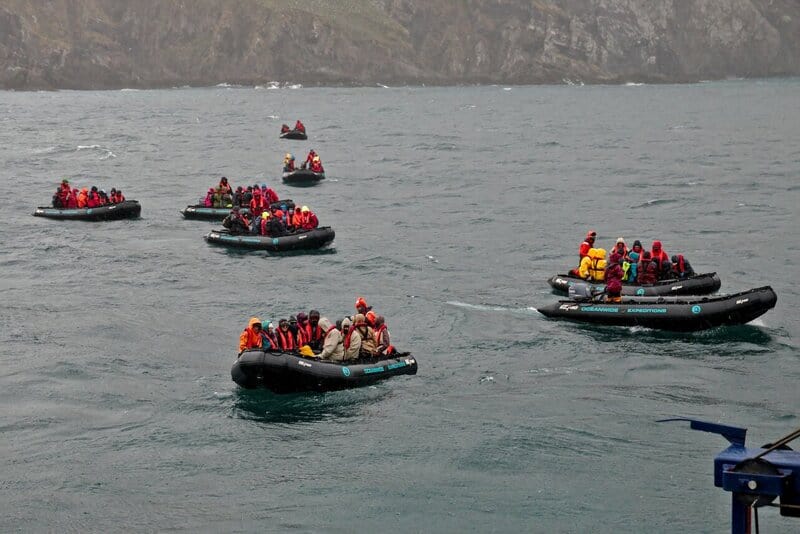
We were incredibly lucky and only had 2 of 19 landings canceled by wind (and one by too many seals to land on the beach). The staff kept saying how rare this was and that we were the luckiest cruise they’ve had in a long time.
The cruise before us – which was entirely booked by a Chinese travel agent – had the exact opposite experience. They went to Antarctica for four days and could not land even once due to the weather.
Imagine that. You spend $8,000 on the trip of a lifetime yet don’t get to set foot on Antarctica. The disappointment would have been too much for me to handle. This is very rare though.
While most cruises will have days where they cannot land, it is unlikely you will be as unlucky as that poor Chinese group. Either way, you must be prepared to have some of your excursions onto land canceled by the weather.
What to Expect on the Cruise Ship
Let’s run through a few things about the ship itself. This is not a cruise ship in the classical sense of the term (unless you book one of the more luxurious cruises that accommodate more people that I do not recommend). Your ship was most likely a research vessel that was converted into a passenger ship after years of service in the Arctic and Antarctic.
The ship will probably have the following:
- Incredibly basic passenger and crew cabins
- Dining room
- Small bar with limited drink options
- Movie room (mostly for educational videos)
- Multiple outdoor decks on multiple levels
That’s really about it.
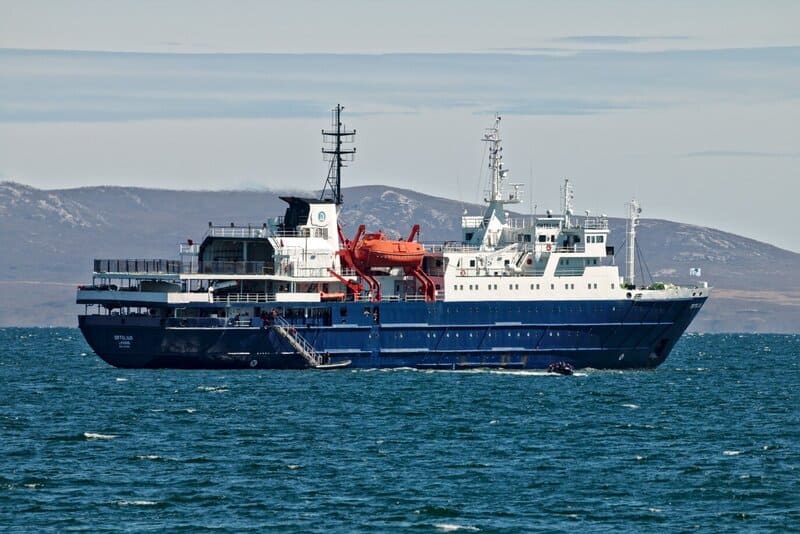
Food
I can only speak to my own experience with Oceanwide Expeditions but the food on our cruise was amazing. The chef was from Austria and cooked up some of the best meals I’ve ever had in my life. The cuisine varied every day. Only breakfast was repetitive.
Breakfast and lunch were buffet-style, whereas dinner was a sit-down order from a menu (usually 2 or 3 options only). Dinner portions were substantial, more American than European in that sense.
There is no snack bar or anything. If you like to snack between meals you will need to bring your own snacks on to the boat and keep them in your cabin. There are plenty of large grocery stores in Ushuaia to choose from. I found the meals satisfying enough that I never found the urge to snack between set meal times.
Bar
We had one small bar on our ship. It had three types of beer and wine as well as an array of hard liquor. Unlike food, alcohol is not included in the cost of the trip (non-alcoholic beverages were included though). Each passenger had a tab and we paid at the end. I barely ordered anything over 19 days but plenty of passengers hit the bar hard every night.
We brought on multiple bottles of Argentine wine, but we could only drink them in our room. We were not allowed to bring our own wine anywhere on the ship.
Rooms
I discuss room types in my post about preparing for the cruise to Antarctica so check that out for detailed information about the rooms. The room you stay in will vary greatly depending on which cabin class you booked and your operator.
Overall, the rooms are small and utilitarian. They are not intended to be super comfortable. In your room, you will likely spend most of your time in bed, as there isn’t much else in it.
Activities
There is really not that much on the ship to entertain you. If there are no whales being spotted from the deck, you can get seriously bored on the days at sea.
Every day we had an educational talk in the movie room or they showed us some videos about South Georgia Island. But this was a small chunk of the day. Most of the time you have to keep yourself busy.
My wife and I used the time to sleep. We slept A LOT. It was the first time in our lives we had the opportunity to just nap whenever we wanted. There is no internet to distract you, which might sound hard but we found it so refreshing.
We read books, watched movies on the computer, and chatted with fellow passengers on the deck. But mostly we just rested. I found the gentle rocking of the boat soothing. It just put me right to sleep. I felt so refreshed after the cruise.
Sleep was nice but sometimes we would be woken up by an announcement on the loudspeaker. If a whale or large iceberg was spotted the crew will announce it so you don’t miss it. I honestly didn’t care too much for seeing whale tales so I usually just fell back asleep!
The people you meet
The most interesting part of our experience was all the eclectic people we met. While we slept a lot, we also spent a lot of time getting to know the other passengers. Some we made friends with and met in Europe years later.
There were people from all over the world, but the majority came from Europe. Though there were actually more Americans than I expected. There were a lot of retirees but also people in their 20s.
The average age of passenger I would say was about 55. We were 31 at the time, but didn’t feel out of place. Everyone on this journey will be a seasoned world traveler, and sharing travel stories with the other passengers was one of our favorite things to do.
A Typical day on a Cruise to Antarctica
Let’s look at what a typical day looks like on a day that you get to go ashore. A typical day at sea is just filled with whatever activity you want to do to keep yourself from getting bored.
Morning
You will wake up early for breakfast before preparing to go ashore. It’s an orderly process to get everyone on the zodiacs. You’ll board one at a time and there are crew members that can help you get into the boat so you don’t fall into the freezing waters. It’s usually a 2-3 minute ride to land and the zodiac will drop you off on a beach.
The excursions onto land last between 1-4 hours. Mostly you are free to wander. The staff will give you some key spots to hit but it’s not a guided walk or anything like that.
It’s your responsibility to get back to the beach in time. If you want to go back earlier (why would you do that?) you can always ask a crew member and they will call a zodiac to take you back.
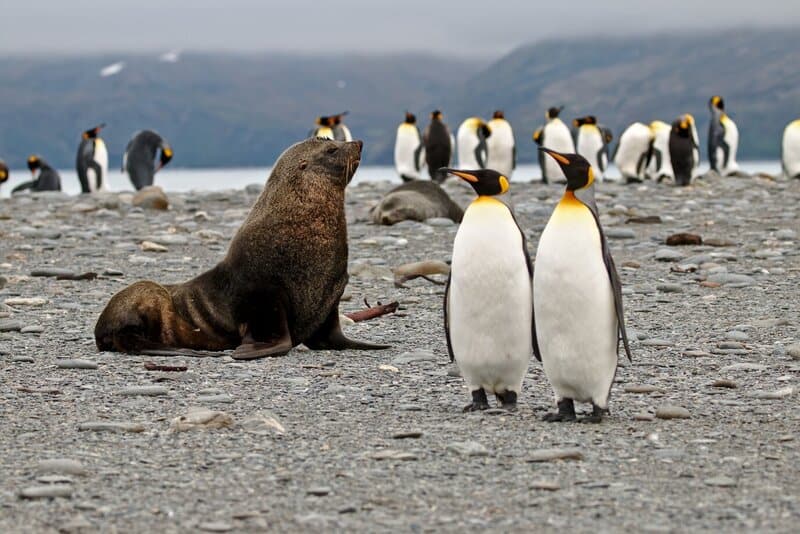
While on land you’ll likely spend the hours taking in the immense beauty of the landscape and observing the wildlife. Penguins are quite entertaining and you easily find the hours pass just watching them waddle around and jump in and out of the ocean.
If you go to South Georgia you will be treated to elephant seal fights and you’ll probably get up close and personal with a few fur seals. No matter where you choose to walk around on land you’ll be disappointed when you have to head back to this ship.
Afternoon
After a buffet lunch you’ll prepare to go back onto land. The ship will have sailed to another landing spot, most likely with a colony of a different type of penguin than you saw in the morning. Some parts of Antarctica have rocky shores and some have very icy shores.
The staff know all the best places so they won’t take you to two places that look the exact same. As the afternoon winds down you’ll wish you had more time on land, but you’ll be thankful you were lucky enough to have this experience at all.
Evening
On your cruise to Antarctica you’ll have plenty of free time after you are back on the ship before dinner, which you might want to use to go through all your photos from the day. Dinner is the main event of the day on the boat. You’ll have time to catch up with your fellow passengers over amazing food after a memorable day.
If you booked the classic Antarctica cruise you’ll get four days like this, depending on the weather. If you booked the South Georgia cruise you’ll get about 10 days (though at least one day will be a half day, i.e. only one landing), as you’ll get two days in the Falklands, four days in South Georgia, and four in Antarctica.
Wildlife
The main attraction that draws people to doing a cruise to Antarctica is without a doubt the wildlife. Colonies of penguins stretch for miles across the beaches.
While you can see penguins in places like South Africa, Patagonia, Australia and New Zealand, nothing compares to the penguin populations you will see on Antarctica. If you go to South Georgia and the Falklands you will see even more, plus tens of thousands of fur and elephant seals.
Here is a quick rundown of the unique wildlife you will see on your trip. Unfortunately you will almost surely not see an emperor penguin, the largest of the penguin species, as they live further south off of the Antarctic Peninsula.
Gentoo Penguin
These little guys with their orange beaks are funny. They have a hilarious waddle and can be found all over the place. They live more spread out than other penguins, usually one family every 25 feet or so. You are pretty much guaranteed to see gentoos on your expedition.
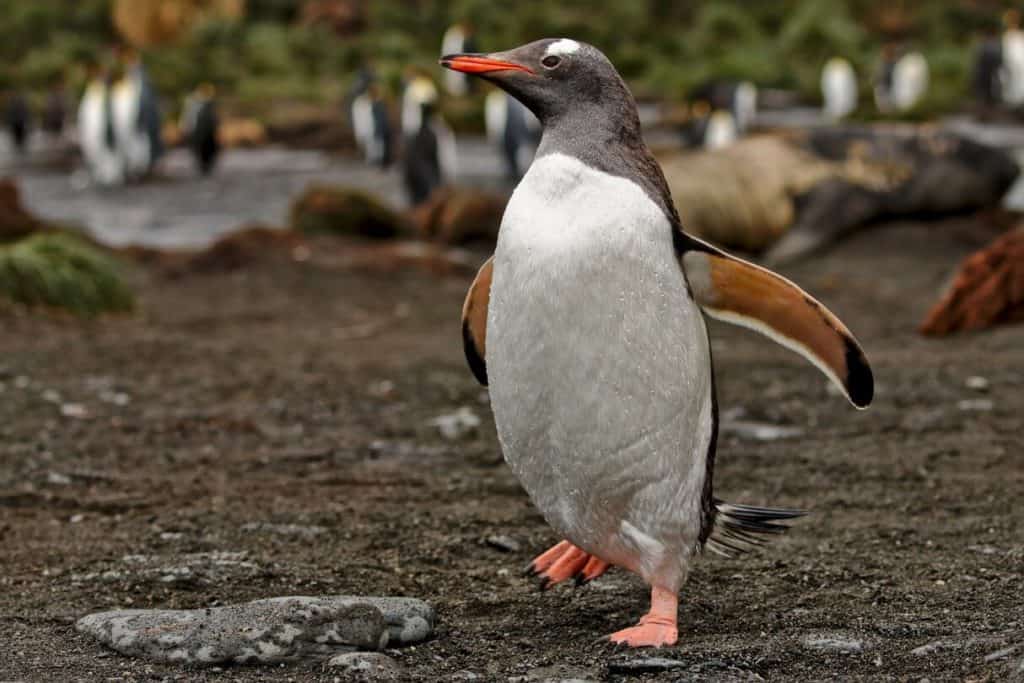
Magellanic Penguin (Falklands only)
These penguins look similar to the penguins you find in South Africa. They don’t like the super cold so you won’t find them in Antarctica and probably not in South Georgia either. But you’ll see tons of them on the Falkland Islands. There are also numerous colonies of magellanic penguins in Chile and Argentina.
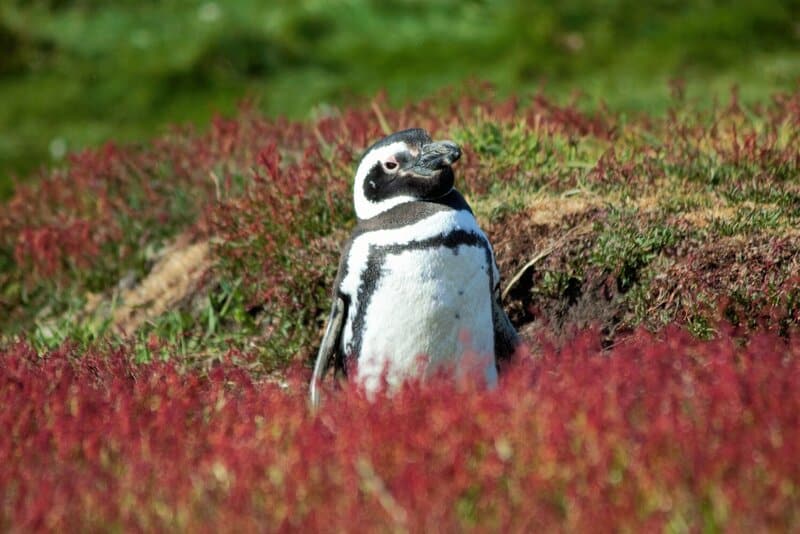
King Penguin (South Georgia and Falklands only)
The king penguin really is the king. The second largest species of penguin, they are considerably larger than the other species you will run into. With bright yellow necks and beautiful beaks, they glide across the water and strut across the land.
These penguins are the highlight of the trip to South Georgia for most people. You’ve gotta do the South Georgia cruise to see them though. Antarctica is a bit too cold for these guys.

Chinstrap Penguin
Chinstrap penguins are small and less colorful than other species. Just black and white, they have a thin black line that goes around their chin, earning them their name. They hang out on the Antarctic islands mostly, but can be spotted on the mainland too.
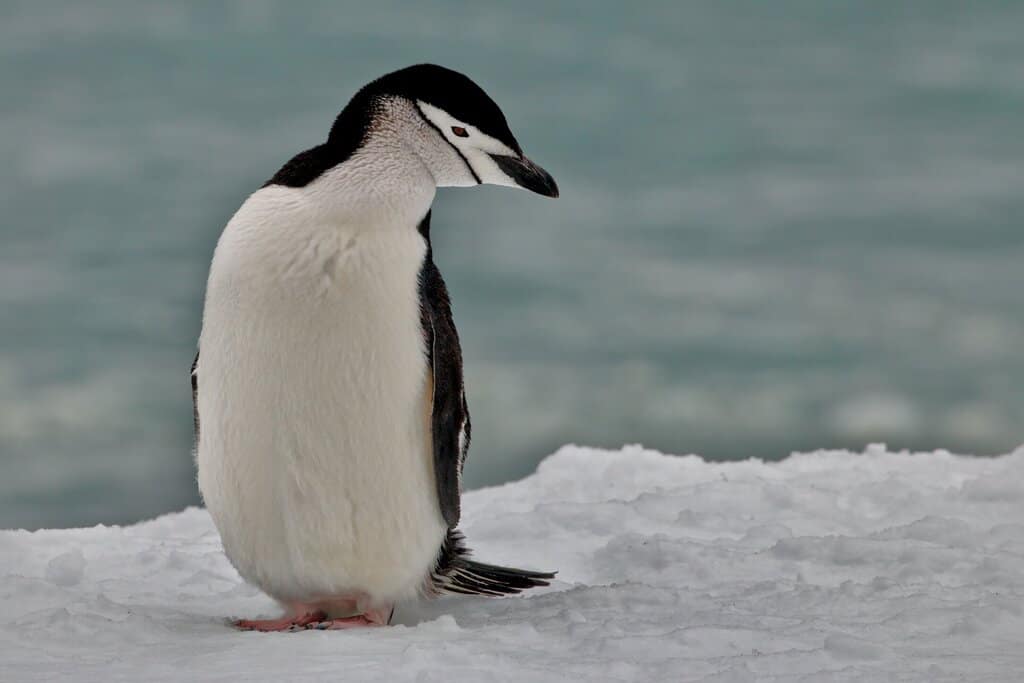
Adelie Penguin
Similar to the chinstrap, but way funnier. Watching these guys run around the beaches of Antarctica was worth the price of admission. They live in huge colonies and run out to sea to go fishing a lot. They are pretty adorable.
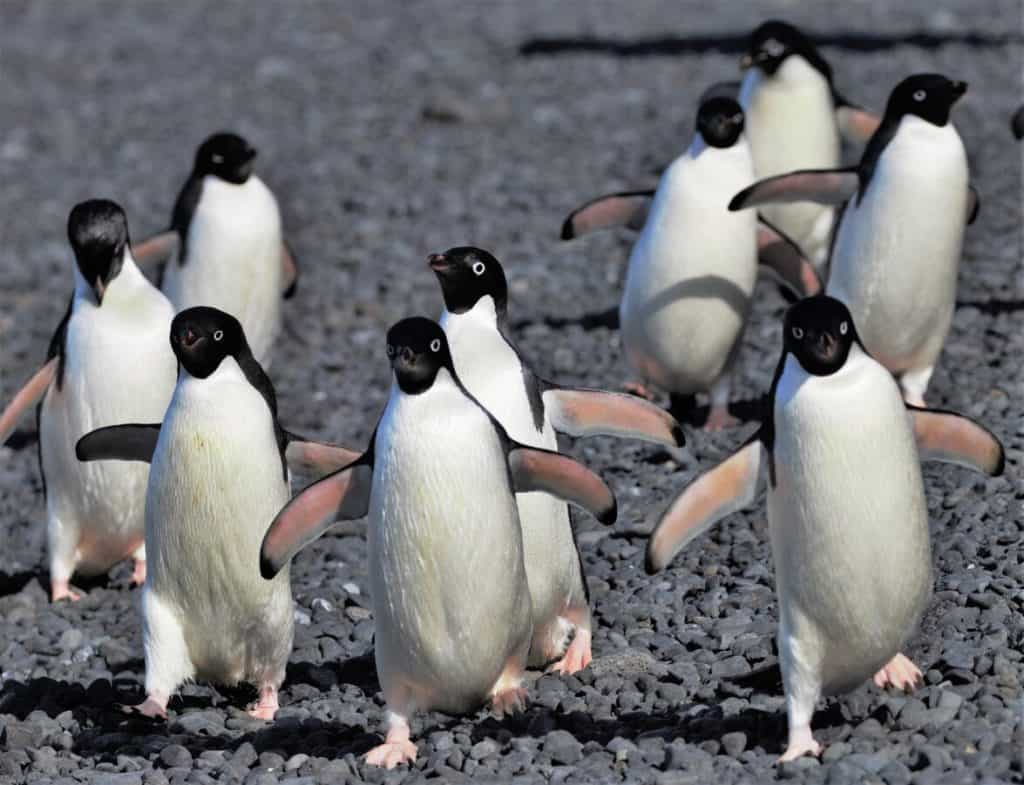
Rockhopper Penguin (Falklands only)
Probably the most bad-ass looking of all the penguin species, the rockhopper gets its name from the fact that they like to hop down rocks. They can do this because you’ll only find them on the subantarctic islands that are not covered in ice. On this trip your only chance to see them is on the Falkland Islands, but they can also be found on other subantarctic islands around the world.
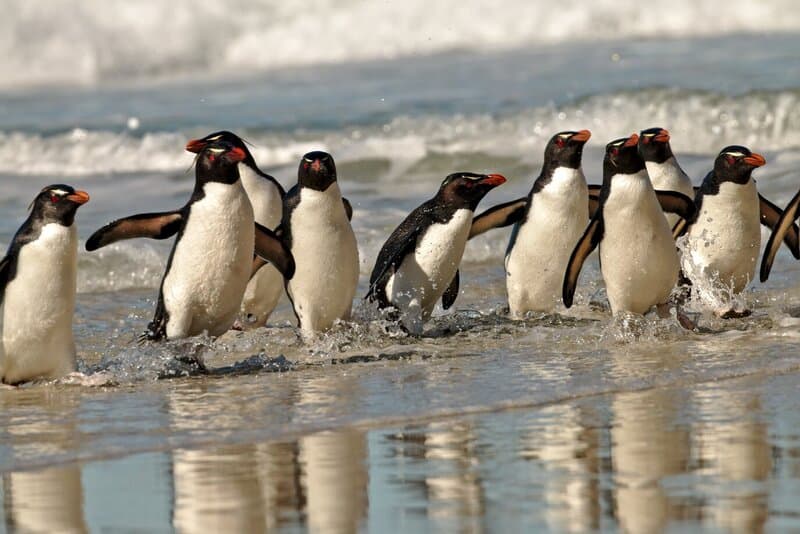
Macaroni Penguin
The most elusive of the seven penguin species you might see, these guys can be found at any of your destinations, but are usually not in large groups outside of two specific beaches on South Georgia.
We only saw them mixed in with colonies of other species and only two at a time. We also saw some in the water swimming around but we were unable to land at the large macaroni colonies in South Georgia due to wind.

Fur Seal (South Georgia only – possible, but unlikely to see in Antarctica)
The fur seal is really the only dangerous animal you will encounter on your Antarctica cruise. You don’t want to get bit by one. The males have massive teeth and can run freakishly fast.
They are usually chill but can suddenly become aggressive and charge you. All you have to do is raise your hands above your head and scream and they will back away. While the adults are large, the babies are adorable. We saw thousands of the guys on South Georgia Island. You probably won’t spot them in Antarctica though.
Elephant Seal (South Georgia only)
The largest species of seal on the planet is the southern elephant seal. You can spot elephant seals on the California coast, but these guys are a whole different ball game. The males can weigh up to 4000 kg (8,800 pounds). That is in sane. They are simply massive.
Unlike fur seals, they are not a threat (unless you fall asleep on the beach and one lays on you). They are incredibly slow, moving only a few meters every minute. The males can have epic fights though. The winner scores the ladies!
Don’t count on seeing these guys in Antarctica though. You’ll have to book the South Georgia cruise to witness an elephant seal battle in person.
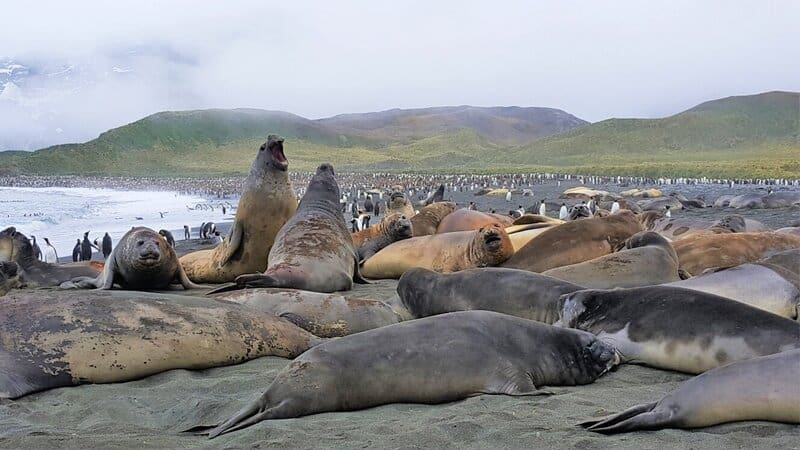
Leopard Seal
The leopard seal is pretty elusive and you probably won’t see one on your Antarctica cruise. We didn’t. They spend a lot of time in the water hunting penguins off the coast of Antarctica.
Weddell Seal
The only seal we saw in Antarctica was the weddell seal, and we did not see many. They are not sprawled across beaches like elephant seals or fur seals in South Georgia. But you’ll probably run into a few of them wandering around the Antarctic Peninsula.

Crabeater Seal
Crabeaters are similar to weddell seals, but they are a little bigger. We didn’t see any of these guys so I don’t have a photo of one.
Whales
Whales will most likely be seen from the ship during your cruise to Antarctica. Humpback and Right whales swim freely in the Southern Ocean during the summer. We never got to see one up close but saw many tales and a few jumping out of the water.
Orcas were also spotted by a crew member, but I didn’t see them. Blue whales could theoretically be found, but there are far fewer of them than there were 100 years ago so seeing one is rare.

Other birds
Penguins are only some of the birds you will see. There are many others, including:
- Petrel
- Albatross
- Tern
- Skua
- Blue-eyed shag
- And many more smaller bird species

Potential Trip Disruption
I’ve talked before about managing your expectations when it comes to the weather. But not landing due to weather is not the biggest concern you have to worry about. The biggest disruption to your trip could be a health emergency. And not just to you. To anyone on board.
There is always a doctor on board, but if somebody needs more urgent medical attention there is only one option, and that is to sail back to Ushuaia or the Falkland Islands.
When that happens your trip is most likely over, depending on where you are geographically when the emergency happens. And sadly there are no refunds. A medical evacuation for one passenger affects everyone.
Seal bites
An uncommon but potential cause of trip disruption for those on the cruise to South Georgia Island is bites from fur seals. Fur seals can be quite aggressive and have massive teeth. You do not want to get bit by a fur seal. If you do, the ship will immediately turn around to get you to the nearest hospital, usually a day or two away on the boat.
You don’t want to be the person who ruins everyone’s trip by getting bit by a seal. You also don’t want to get a seal bite because they carry all sorts of viruses.
On the boat they’ll teach you what to do when a fur seal charges you. It will happen at least once if you go to South Georgia. They are everywhere. It’s quite simple to scare them away, just raise your hands above your heads and scream at them. But you have to always be paying attention.
Luckily, seal bites don’t happen that often, but every staff member has been on at least one expedition that had to turn back when someone got bit by a seal.
Medical emergencies
A more likely cause of the end of your journey is someone’s medical emergency. This you really have no control over and you just have to hope everyone remains healthy on the cruise!
What to Expect in Antarctica – Final Word
Hopefully this rundown of what to expect on your cruise to Antarctica has prepared you to have an awesome vacation to the White Continent. Just writing this made me long for another trip. This will be unlike anything you’ve ever done before and will leave you with memories that will never be replaced. Enjoy the journey!


2 comments
Totally fantastic. Your photography is awesome!
Thanks! Photos are a combination of ours and a few friends from the trip!